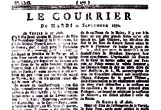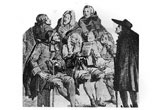 |
||||||||||||||||||||
 |
||||||||||||||||||||
 |
||||||||||||||||||||
 |
||||||||||||||||||||
|
Analyzing Documents presents case studies that show how scholars interpret different kinds of historical evidence in world history. Here is an 18th-century French newspaper, Le Courrier d’Avignon, and an image of the reading public in France around the same time. By the late 18th century, newspapers had become important means of communication in France, England, and other countries. Papers like Le Courrier d’Avignon had correspondents in many cities and reported on both domestic and international news. Newspapers offer an important window into the past, but to understand them as a historical source, it is important to look at the newspaper, competing newspapers, literacy, and to ask how people read newspapers in different times and cultures.
What do you first notice about the newspaper? How does it compare to 21st-century newspapers in the United States? In other countries? How is the layout different? Now look at the image of a group of people reading the Gazette. What does this image tell you about who read newspapers? How they read them? How easy or difficult it was to access newspapers?
Now listen to Professor Jack Censer talk about newspapers and what we can learn from them.
|
||||||||||||||||||||||||||||||||||||||||||||||||||||||||||||||
|
finding world history | unpacking evidence | analyzing documents | teaching sources | about |
|


